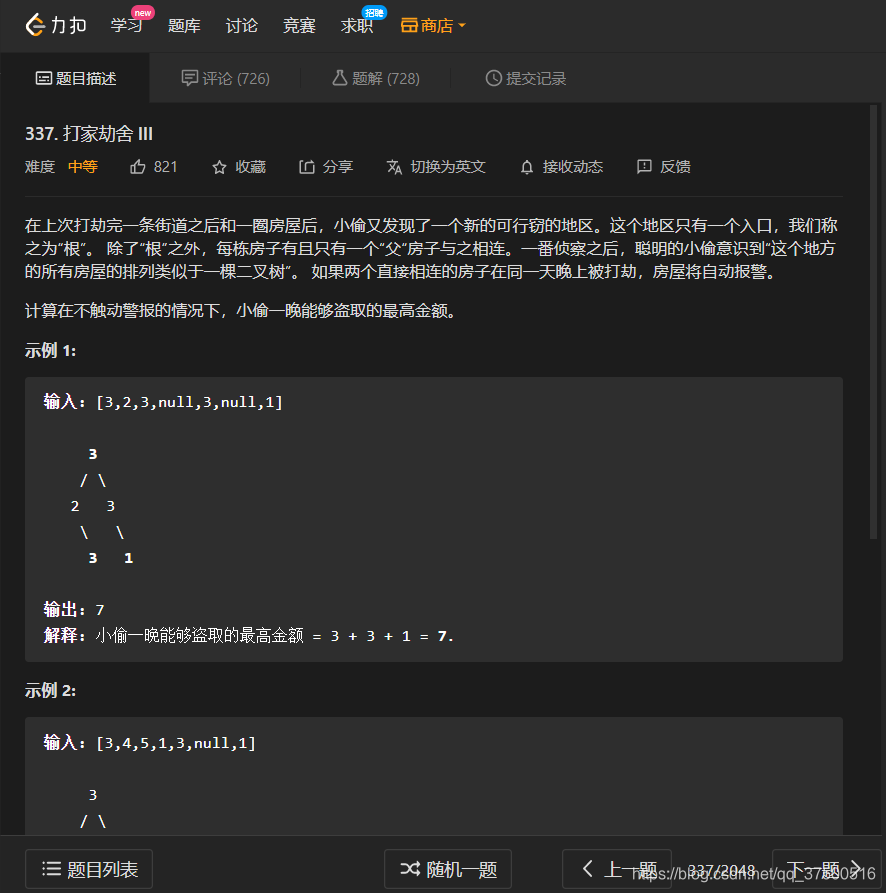Leetcode 337. 打家劫舍 III(DAY 88) ---- Leetcode Hot 100
本文共 1034 字,大约阅读时间需要 3 分钟。
原题题目

代码实现(首刷自解 之前没做明白 说明3个月的提升aaa)
/** * Definition for a binary tree node. * struct TreeNode { * int val; * TreeNode *left; * TreeNode *right; * TreeNode() : val(0), left(nullptr), right(nullptr) {} * TreeNode(int x) : val(x), left(nullptr), right(nullptr) {} * TreeNode(int x, TreeNode *left, TreeNode *right) : val(x), left(left), right(right) {} * }; */class Solution { public: unordered_map m; int rob(TreeNode* root) { if(!root) return 0; if(!root) return 0; int l = rob(root->left); int r = rob(root->right); int ll = 0,lr = 0,rl = 0,rr = 0; if(root->left) { ll = m[root->left->left]; lr = m[root->left->right]; } if(root->right) { rl = m[root->right->left]; rr = m[root->right->right]; } if(l + r >= ll + lr + rl + rr + root->val) m[root] = l + r; else m[root] = ll + lr + rl + rr + root->val; return m[root]; }}; 转载地址:http://fcni.baihongyu.com/
你可能感兴趣的文章
Netty工作笔记0046---异步模型原理剖析
查看>>
Netty工作笔记0047---Http服务程序实例
查看>>
Netty工作笔记0048---Http服务过滤资源
查看>>
Netty工作笔记0050---Netty核心模块1
查看>>
Netty工作笔记0051---Netty核心模块2
查看>>
Netty工作笔记0052---Pipeline组件剖析
查看>>
Netty工作笔记0053---Netty核心模块梳理
查看>>
Netty工作笔记0054---EventLoop组件
查看>>
Netty工作笔记0055---Unpooled应用实例1
查看>>
Netty工作笔记0056---Unpooled应用实例2
查看>>
Netty工作笔记0057---Netty群聊系统服务端
查看>>
Netty工作笔记0058---Netty群聊系统客户端
查看>>
Netty工作笔记0059---Netty私聊实现思路
查看>>
Netty工作笔记0060---Netty心跳机制实例
查看>>
Netty工作笔记0060---Tcp长连接和短连接_Http长连接和短连接_UDP长连接和短连接
查看>>
Netty工作笔记0061---Netty心跳处理器编写
查看>>
Netty工作笔记0063---WebSocket长连接开发2
查看>>
Netty工作笔记0065---WebSocket长连接开发4
查看>>
Netty工作笔记0066---Netty核心模块内容梳理
查看>>
Netty工作笔记0068---Protobuf机制简述
查看>>